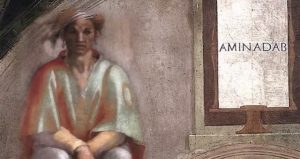I must admit, I’m disappointed. [Even more so with the response… see update at bottom.]
When Rabbi Adlerstein and I started Cross-Currents, I used to read various critical responses to my essays on several blogs. It was not long, though, before I realized that to read them was foolish — there are some bloggers who will quite reliably insist that the sun rises in the west simply because an observant Rabbi has said otherwise. [This is the same reason Rabbi Avi Shafran declines to publish comments to his essays.] Since then, people have occasionally written to ask why I offered no response to various online critiques and rebuttals, and “a waste of time” has been my inevitable answer.
 There are some, though, of whom you expect more. And last night, someone asked me to look at a post by a moderately well-known writer and blogger. You’ll all know who he is, but I’m not going to link to the post for a different (yet similar) reason than I didn’t link to the viral video of yesterday — I hope he’ll regret posting it, because he should, even if he doesn’t yet.
There are some, though, of whom you expect more. And last night, someone asked me to look at a post by a moderately well-known writer and blogger. You’ll all know who he is, but I’m not going to link to the post for a different (yet similar) reason than I didn’t link to the viral video of yesterday — I hope he’ll regret posting it, because he should, even if he doesn’t yet.
This is personally disappointing because we used to be friends, and I persisted in believing that we were. On one of his early trips to Baltimore to talk about zoology and Torah, he stayed in our house. His best line was when my wife said that “bats aren’t bugs,” and he immediately recognized the source: “I am expert on two things. Zoology, and Calvin and Hobbes.”
Even after his books were condemned by Gedolim, he remained a client — our work for other Jewish organizations led to doing commercial web hosting, and although I have sold my interest, I believe he’s still using that service. So whether or not I agreed with him, we were hosting his rejection of the ban. This remained true even after I was asked by Rav Aharon Feldman, shlit”a, to review Rav Meiselman’s book, “Torah, Chazal and Science,” for the journal Dialogue.
Now although Rav Meiselman doesn’t name names, it was obvious to whom he was referring when he wrote in his preface that:
A spate of books and articles and a nonstop discourse in the blogosphere have attempted to introduce a radical new theology and proclaim it compatible with classic Jewish belief. Most of this literature has been sophomoric at best. In general it has not been written by people trained simultaneously in Torah and science, whereas the topics dealt with often involve complex issues, calling for expertise in both.
So I understand why he wasn’t too pleased with the book, and that he probably wouldn’t enjoy my favorable review. But you know, that’s how things are sometimes, and the truth is best served when we don’t involve our personal animus or emotions.
As it happens, my review included addressing criticisms found in two other reviews, both critical of Rav Meiselman’s position. One of those critical reviews was written by the person who took over publication of the banned books after they were dropped by their previous publisher, and with whom I’ve collaborated on several matters. I carefully expressed my feeling that “when a person starts off with such an obviously negative perspective, it is that much more important to base criticism upon clear errors or contradictions, and reference other, more neutral sources to support his position.”
And in that case, we apparently succeeded in avoiding personal conflict. That reviewer wrote to me that he welcomes criticisms of his writing and looks forward to future cooperation in the many important areas where we largely and/or entirely agree.
Not so, apparently, when it comes to the blogger’s opinion of my review. There is no reason for disagreements to involve falsifications or straw man arguments, of course, but what upset my friend were the personal attacks. I may indeed be a “charedi polemicist,” but in context it didn’t seem that he meant that as a compliment. And what ended up happening is that in his effort to make me look foolish, he either falsified my words or those of Rav Meiselman, or mocked the words of the Rambam — all of this in a post entitled “Adulating Dishonesty.” One is reminded of the old adage found in the Gemara about projecting one’s own defects onto others: Kol HaPosel, B’Mumo Posel, all who invalidate use their own defects to do so.
In the first paragraph, the blog asserted that Dialogue “coincidentally” has Rabbi Meiselman on the editorial board. This is incorrect, and the blogger cannot use a non-fact to imply collusion or censorship (the word “coincidentally” can only be read in context as insinuating that this was anything but coincidental). While Rabbi Meiselman was a member of the Rabbinic Board governing previous issues, and was so listed on the inside front cover of those issues, he is no longer listed — for he left the board prior to the compilation of the current issue. He had no input or control regarding any part of my submission. His former membership of the Rabbinic Board cannot serve to impugn the credibility of a review written after his departure.
The second paragraph, though, was what surprised me. I will address this in detail, so that the reader may see for him or herself. Here is the paragraph in question from the blog post (minus the last sentence, which transitions to the main sections):
Some of Rabbi Menken’s eager adulations of Rabbi Meiselman’s book are hilarious. For example, Rabbi Menken notes that an example of Chazal’s advanced knowledge of the natural world is that they presented Pi as being three, because this must have been because they knew it was an irrational number and cannot be expressed exactly!
There are no additional words related to this subject in the blog post; this quote is both complete and entirely in context. The clear implication of his words is that Chazal presented Pi as being three, and that I or Rabbi Meiselman (or both) suggested that it “must have been” that Chazal knew that Pi was an irrational number — projecting current mathematical knowledge back into the distant past in order to excuse a coarse estimate, and then using that very projection to tout Chazal’s prescience. This, of course, would be ludicrous, and an apt target for rich mockery. And that is indeed his point, to use this as an example of “hilarious” adulation.
Yet here is what I actually wrote:
The author [Rav Meiselman] cites many similar cases in which Chazal possessed knowledge of the physical world beyond what was known to other cultures. For example, the ratio of the circumference to the diameter of a circle (pi) is an irrational number, meaning it cannot be expressed as a ratio of integers. This was only established by contemporary mathematicians in 1768, but the Rambam explains that the reason why Chazal used the approximation of 3:1 is because the actual ratio cannot be stated definitively in any case (p. 154).
Nowhere did I suggest that it “must have been” that Chazal knew that three was merely an approximation of Pi, which they knew to be an irrational number. What I wrote is that the Rambam said that this was so. And the Rambam, of course, said this many centuries before mathematicians achieved the same understanding.
And here, further, is the referenced passage from page 153-154 of Rav Meiselman’s book:
Let us begin with the example of Pi, which we referred to in the course of an earlier discussion. This number, which is both irrational and transcendental, is the ratio of the circumference of a circle to its diameter. It seems that one of the first definitive statements of its irrationality in recorded history is that of the Rambam in his Peirush Hamishnyos. In contemporary mathematics this fact was only established by the German mathematician Johann Heinrich Lambert in 1768.
The Rambam gives no source for his information. Scholars have presumed that he deduced it from Talmudic passages in which it is implied. In fact, the Rambam seems to say so almost explicitly. He writes that Chazal use an approximation for Pi rather than a fraction because it is irrational. This seems to imply that if Pi were rational there would be no justification for instituting a legal approximation rather than the appropriate fraction. The very fact that Chazal did so indicated to him that they knew it to be irrational.
Again, the idea that Chazal knew three to be a rough estimate for Pi, which they further knew to be an irrational number, is attributed directly to the Rambam. Rav Meiselman provides extensive footnotes throughout his book, and includes the text of the Rambam’s Pirush HaMishnayos, Eruvin 1:5, which shows the attribution to be accurate, in two notes on page 154. Note that as the Pirush was originally written in a Judeo-Arabic dialect and later translated, there are minor differences between the text of Rav Meiselman’s footnotes and the text as found in the back of Maseches Eruvin in a Vilna Sha”s. But please don’t believe my translation, you are invited to do your own of either version:
You must know that the ratio of the diameter of a circle to its circumference is unknown, and impossible to express precisely. And this is not due to our lack of understanding… [rather] it is by its nature unknown, and cannot be fully known… but it is possible to estimate… The best estimate used by academic scholars is a ratio of one to three and 1/7… And since this will never be entirely understood except by approximation, they (Chazal) took a large number and said that anything that has three in its circumference has a diameter of one, and they relied upon this in what was required for measurements in the Torah.
If we translate his language to that used by mathematicians today, the Rambam said that Pi is an irrational number, as Rabbi Meiselman wrote — “a real number that cannot be expressed as a ratio of integers, i.e. as a fraction… irrational numbers, when written as decimal numbers, do not terminate, nor do they repeat.” [Pi is the paradigm used in the Wikipedia article.] It can never be fully known. Supposedly mathematicians have reached 12.1 trillion digits.
So here is why I am disappointed:
Did I say that Chazal presented Pi as being three, because “this must have been” because they knew it was an irrational number? Of course not. Did Rabbi Meiselman? Once again, of course not — and we know the blogger has Rav Meiselman’s book, because he says himself that he is “steadily working through” its contents.
Rather, it was the Rambam who said so, 600 years before modern mathematicians reached this same conclusion. In the Rambam’s time, this statement was hardly projecting “current knowledge” back onto Chazal, because even then the nature of Pi remained unknown. On the contrary, the Rambam’s statement itself is evidence that “Chazal possessed knowledge of the physical world beyond what was known to other cultures.”
So the author of the statement found so “hilarious” by the blogger is: the Rambam.
The reader of the blog post in question is led to mock the very idea that Chazal knew Pi to be an irrational number — in other words, to mock the words of the Rambam.
I cannot speculate upon whether the blogger actually read and comprehended this portion of Rabbi Meiselman’s book before erecting his straw man and leading the reader to mock a profoundly insightful statement of the Rambam. I don’t see, though, why it is relevant. Whether deliberately or through negligence, he led the reader to mock Divrei HaRambam!
What I can say is that I hope this 2000-word exercise is helpful and enlightening to some readers, and at least explains both my disappointment and why I will decline to address such things in the future. It’s clear at this point where the dishonesty lies.
[His response is yet more saddening and revealing. First, the writer posts a picture of Voldemort with a caption reading “he who must not be named.” Even some of his supporters termed his initial post attacking me “rabid,” but because I did not want to descend to his level, and condemn him while naming names, I’m apparently to be criticized for that too. It’s no surprise, really.
In his latest essay, he makes unsourced claims about Greek and other knowledge in order to portray the Rambam’s statement about Pi as a common insight: “But it was known to be irrational long before” Lambert proved it, he says.
History says otherwise. Lambert’s colleague Leonhard Euler believed that Pi was irrational, but could not arrive at a proof. It was Euler who got Lambert a position at the St. Petersburg Academy of Sciences. Later, Lambert arrived at a proof for Euler’s belief. So the blogger’s claim is simply not correct.
The Rambam, on the other hand, says categorically that it is impossible to arrive at an exact value of Pi, 600 years earlier.
And once again, the blogger does not read the Rambam. He says “Rambam surely didn’t get it from the Gemara, or he would have said so.”
I’m sorry, but this is simply breathtaking. I know that he has no formal training in any scientific field, but I did think he possessed a yeshiva-level familiarity with Jewish sources. Yet everyone at that level knows that the Rambam in particular was unlikely to provide source references, even in Halachic areas. This is true even in the Mishnah Torah, and all the more so his Pirush HaMishnayos. No one who has read even a few Perakim of Rambam could support this blustering assertion.
But furthermore, the Rambam quite clearly states that Chazal knew that Pi was irrational, independent of the question of the Rambam’s source for this information — although, once he tells you that Chazal knew it, there is no longer much of a question. He says: “and since this will never be entirely understood except by approximation, they (Chazal) took a large number.”
In order to avoid this, he offers another demonstration of his penchant for straw man arguments:
Rambam says that Chazal knew that Pi was irrational, and therefore used an approximation. This is a reasonable position. Yet Rambam does NOT say, however, that the fact of Chazal using three proves that they knew it to be irrational.
That is correct, and no one said otherwise. The Rambam says that Chazal knew it to be irrational and therefore used three. That is what Rav Meiselman wrote, and what I wrote.
Understand that Chazal were not afraid of fractions. In order to indicate the length of lunar months, an hour is divided into 1080 portions, because a lunar month is 29 days and 12 + 793/1080 hours. Note that 792/1080 is 11/15 — but Chazal needed greater precision!
It is as the Rambam says, and as Rav Meiselman understands him: in this particular case, there is no precise value. No matter what estimate one uses for Pi, it will remain an estimate. Anyone with a piece of string can tell that Pi isn’t 3 — on the contrary, had Chazal used a more precise estimate such as 3 and 1/7, people like this blogger would have held it up as evidence that Chazal didn’t know math.
Yet further evidence of Chazal’s wisdom!
I think we’re done here.]
 We know so little about this story that I’m not even sure it happened. Probably something like this did somewhere in the civilized world, but we don’t know about it because no one paid attention — we all know of similar stories from the past, even the recent past.
We know so little about this story that I’m not even sure it happened. Probably something like this did somewhere in the civilized world, but we don’t know about it because no one paid attention — we all know of similar stories from the past, even the recent past.
 There are some, though, of whom you expect more. And last night, someone asked me to look at a post by a moderately well-known writer and blogger. You’ll all know who he is, but I’m not going to link to the post for a different (yet similar) reason than I didn’t link to the viral video of yesterday — I hope he’ll regret posting it, because he should, even if he doesn’t yet.
There are some, though, of whom you expect more. And last night, someone asked me to look at a post by a moderately well-known writer and blogger. You’ll all know who he is, but I’m not going to link to the post for a different (yet similar) reason than I didn’t link to the viral video of yesterday — I hope he’ll regret posting it, because he should, even if he doesn’t yet.

 Rabbi Yisrael Salanter, founder of the Mussar movement, explained the Mishnah as follows: When you take a dog out for a walk, the dog goes running ahead, and to the outside observer it might look like the dog is leading, and you are following. But what if you decide to turn right at a corner, and the dog continues on ahead? Within seconds, the dog will be out in front of you once again, running ahead in the new direction you have chosen. The dog isn’t really leading at all.
Rabbi Yisrael Salanter, founder of the Mussar movement, explained the Mishnah as follows: When you take a dog out for a walk, the dog goes running ahead, and to the outside observer it might look like the dog is leading, and you are following. But what if you decide to turn right at a corner, and the dog continues on ahead? Within seconds, the dog will be out in front of you once again, running ahead in the new direction you have chosen. The dog isn’t really leading at all.
